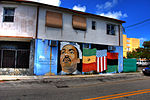Liberty Square (Miami)
1937 establishments in FloridaApartment buildings in MiamiPublic housing in Miami-Dade County, FloridaResidential buildings completed in 1937
Liberty Square (often referred to as the Pork & Beans) is a 753-unit Miami-Dade public housing apartment complex in the Liberty City neighborhood of Miami, Florida. It is bordered at Martin Luther King Jr. Boulevard/North 62nd Street to the south, North 67th Street to the north, State Road 933 (Northwest 12th Avenue) to the east, and Northwest 15th Avenue to the west. Constructed as a part of the New Deal by the Public Works Administration and opening in 1937, it was the first public housing project for African Americans in the Southern United States.
Excerpt from the Wikipedia article Liberty Square (Miami) (License: CC BY-SA 3.0, Authors).Liberty Square (Miami)
Northwest 68th Street, Miami
Geographical coordinates (GPS) Address Nearby Places Show on map
Geographical coordinates (GPS)
| Latitude | Longitude |
|---|---|
| N 25.836111111111 ° | E -80.22 ° |
Address
Northwest 68th Street 1346
33147 Miami
Florida, United States
Open on Google Maps





